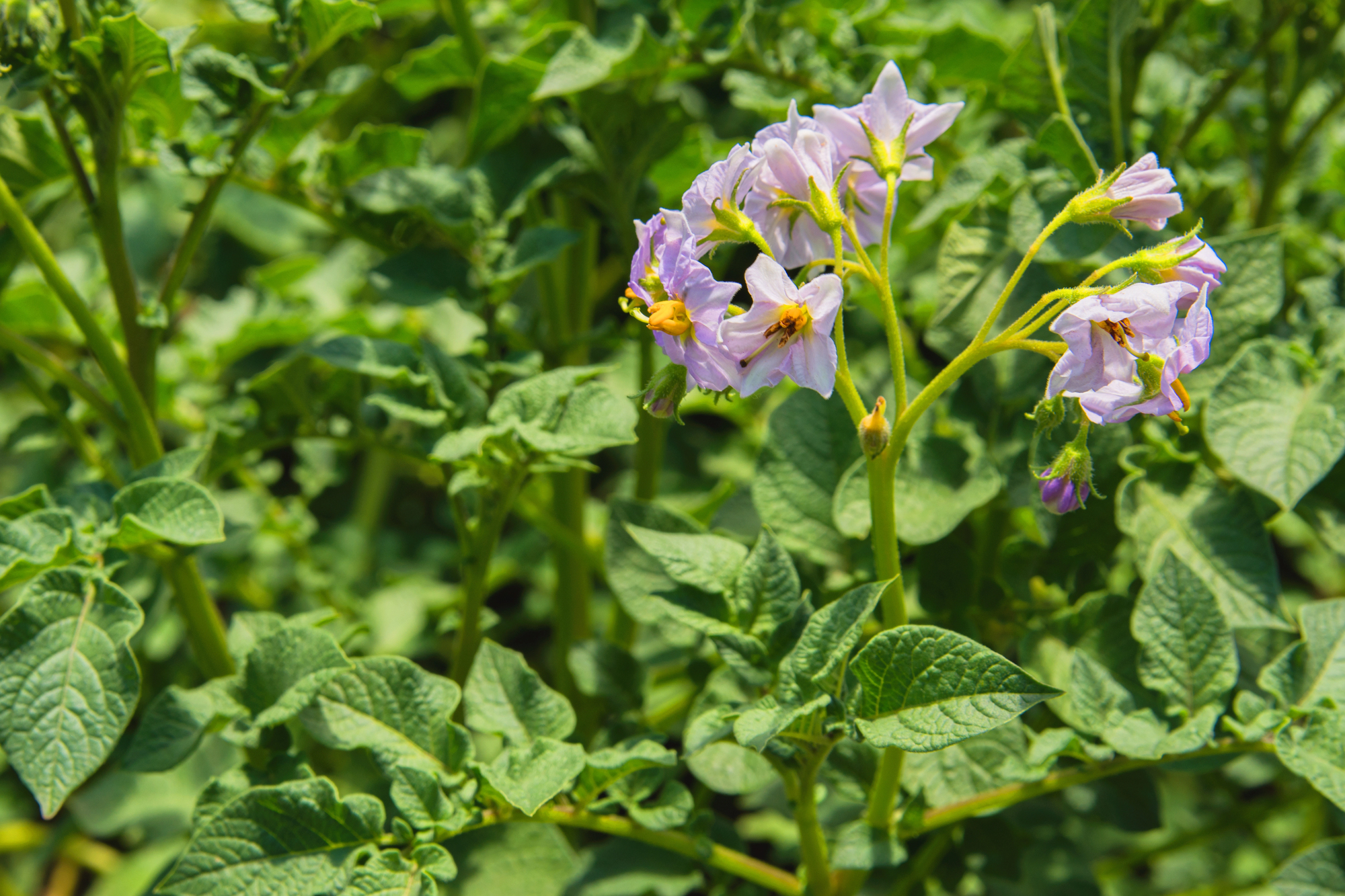Potato Donation Tracker
Quick Links: How & Where to Grow | Temperature | How to Care For | Harvest Signs | Harvesting | Pests | Companions | Varieties | Preservation | Recipes | Michigan Tips | Fun Facts
🌱 How & Where to Grow Potatoes:
- Plant seed potatoes when soil reaches 45-50°F (early April).
- Plant 2-3 inches deep, 12 inches apart in rows 30-36 inches apart.
- Hill as they grow – this is the secret to abundant yields!
- Sunlight: Full sun (6-8 hours) for best production.
- Soil Type: Well-drained, loose soil with pH 5.0-6.0 (slightly acidic).
- Soil Amendment: Add compost but avoid fresh manure which causes scab
Buy certified disease-free seed potatoes – grocery store potatoes are treated to prevent sprouting!
🌡️ Temperature Guidance:
Cool season crop. Best growth 60-70°F. Production stops above 75°F soil.
- Planting: Soil temperature 45-50°F minimum.
- Optimal growing: Air temperature 60-70°F, soil 60-65°F.
- Tubers stop forming when soil exceeds 75°F.
- Light frost kills foliage but not tubers underground.
Michigan’s climate is ideal – our cool springs and moderate summers create perfect potato conditions!
💧 How to Care for:
- Consistent Moisture: Critical during tuber formation (flowering stage).
- Watering: 1-2 inches weekly – irregular watering causes hollow heart.
- Hilling: Add soil when plants are 6 inches tall, repeat 2-3 times.
- Mulch: Straw mulch conserves moisture and keeps soil cool.
- Fertilizer: Side-dress with 10-10-10 when hilling.
📏 Harvest Signs:
New potatoes when flowering. Mature when vines yellow. Storage potatoes after vine death.
- New potatoes have thin, flaky skins and incredible flavor.
- For storage potatoes, wait 2-3 weeks after vines die back.
- Skin should be firm and not rub off easily when mature.
- Morning harvest when temperatures are cool is ideal.
You can “rob” a few new potatoes by feeling in the soil without harvesting the whole plant!
🧺 Harvesting:
Use fork carefully. Harvest on dry day. Don’t wash until use.
- Always dig from the side to avoid spearing potatoes.
- Start 12-18 inches from plant center and work inward.
- Let dry on soil surface for an hour to toughen skins.
- Handle gently – bruised potatoes don’t store well.
- Sort immediately – use damaged ones first.
🪲 Michigan Pests:
Colorado potato beetle (hand-pick), late blight, scab.
- Colorado potato beetles – orange larvae and striped adults devastate plants. Hand-pick daily!
- Late blight – same disease that caused Irish famine. Remove infected plants immediately.
- Scab – rough patches on skin. Maintain acidic soil and avoid fresh manure.
- Wireworms – bore holes through tubers. Rotate crops away from grass.
🫱🏽🫲🏼 Companions:
Good with beans, corn, cabbage family. Avoid nightshades.
- Beans fix nitrogen and deter Colorado potato beetles.
- Horseradish planted at corners may increase disease resistance.
- Marigolds help deter beetles and other pests.
- Avoid tomatoes, peppers, eggplant – they share diseases.
- Never follow potatoes with potatoes – rotate on 3-4 year cycle.
🥔 Varieties:
Early: ‘Red Norland’, ‘Yukon Gold’. Late: ‘Russet Burbank’, ‘Purple Majesty’.
- Early (70-90 days): ‘Red Norland’, ‘Yukon Gold’ – great for new potatoes.
- Mid-season (90-110 days): ‘Kennebec’, ‘Red Pontiac’ – all-purpose.
- Late (110-120 days): ‘Russet Burbank’, ‘German Butterball’ – best keepers.
- Specialty: ‘Purple Majesty’, ‘French Fingerling’ – gourmet favorites.
🫙 Preservation:
Root cellar (cure first), freeze blanched, pressure can only, dehydrate.
- Curing – essential! 50-60°F with high humidity for 10 days heals wounds.
- Root cellar – after curing, store at 38-40°F in dark with ventilation.
- Never refrigerate – cold converts starch to sugar.
- Freezing – blanch cut potatoes 3-5 minutes first.
- Pressure canning only – never water bath can.
- Dehydrate for hash browns or camping meals.
🧑🏽🍳 Recipes:
Potato salad, loaded potato soup, German-style potatoes.
- Nothing beats new potatoes boiled with butter and fresh herbs!
- Make hasselback potatoes for an impressive presentation.
- Traditional German potato salad uses vinegar, not mayo.
- Twice-baked potatoes can be frozen for quick dinners.
- Save potato water for bread baking – adds incredible flavor!
✋🏼 Michigan Tips:
- Multiple varieties for extended harvest.
- Row covers for frost protection.
- Plant early varieties by April 15 in SE Michigan for July harvest.
- Michigan’s humidity increases disease pressure – space plants well.
- Consider growing in containers or bags for easy harvest.
- Late varieties planted in June avoid worst beetle pressure.
🧠 Fun Facts:
- Native to Andes.
- Michigan ranks 8th in US production.
- First vegetable in space!
- Potatoes have more potassium than bananas.
- The Inca had over 3,000 potato varieties.
- A potato is about 80% water and 20% solids.
- French fries were introduced to America by Thomas Jefferson.
- The world’s largest potato weighed 18 pounds 4 ounces!


0 Comments